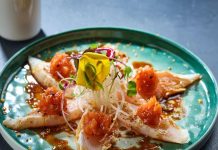Perfectly aligned bottles in a variety of sizes are lit by cyan and magenta bulbs, causing the liquid inside to glisten. The beacons welcome patrons as they enter The Locale, a Boca Raton eatery that serves up global cuisine with a Latin flair and plenty of inventive cocktails. But, with nearly 100 illuminated cylinders, each holding different clear or amber nectar of the gods, choosing just one is a feat. The secret: Ask for bar manager and spirit enthusiast Esteff Lopes. Inspired by Tom Cruise in “Cocktail,” Lopes hopped behind a bar almost 20 years ago and never left. “It’s not even about the spirits,” says the Brazilian native. “It’s about the connections I make every day.”
A few blocks away, Loch Bar, the swanky Maryland-style seafood tavern, recently opened its doors inside Mizner Park. As the second outpost of the brand, Boca’s Loch Bar has a growing whiskey list with a goal to have more than 500 choices on the menu within a year. Owned by brothers Alex and Eric Smith, the Baltimore-based Atlas Restaurant Group’s initial foray into the South Florida scene was the upscale Mediterranean Ouzo Bay, also located in Mizner Park. As the one who oversees the beverage programs for all locations, Eric Smith is the liquor expert you want to share a drink with.
Over at the iconic Boca Raton Resort & Club, there’s a bar that’s not monkeying around with its liquor. Monkey Bar, the property’s speakeasy, is a cavernous wonder of spirits and monkey décor. Inspired by famous architect Addison Mizner’s pet monkey Johnnie, this intimate and inviting space is the perfect spot to chat with beverage director Kirsten Scott over a seasonal old-fashioned cocktail.

Whisk(e)y
Depending on where it’s from, the amber liquid made from distilled fermented grain mash is spelled with or without an “e.” Irish and most American brands use the “e,” while Scotland, Japan and Canada do not. Scotch whisky also only comes from Scotland while Bourbon, made mainly with corn and aged in new charred oak barrels, is made in the States. The Irish and Scots mainly use barley aged in wooden casks and oak barrels respectively.
Johnnie Walker
The name synonymous with whisky, Johnnie Walker has been making its tawny Scotch for nearly 200 years. While its square bottle can be spotted from a mile away, it’s that Johnnie Walker lingering oaky taste that makes it unique, Lopes points out. The brand makes a wide range of whiskies, each differentiated by their label slanted at exactly 24 degrees. The Blue Label, inspired by the original 1867 Old Highland Whisky recipe, is a mixture of Scotland’s most rare whiskies. Only one in 10,000 casks has the quality and flavor to be a part of this blend.
Pappy Van Winkle Family Reserve 23
“Before even sipping a whiskey, take a moment to smell its aroma and admire its color,” Lopes says. By gathering this information, your brain is then ready to sip and enjoy the caramel and oak flavors. As with any high-end whiskey, it’s best to order it neat with a side of water. Then using a straw, transport a few drops of water into the whiskey to draw out the drink’s delicate and sophisticated flavors, Smith suggests. A historic and admired producer, the “Pappy craze,” as Scott calls it, didn’t really begin until 1996 when the Beverage Testing Institute gave the 20-year Pappy a 99 out of 100, the highest ranking ever given to a whiskey, she says. Today, the 23-year bourbon has a highly allocated production where an entire state may only receive a case per year, Smith says. And that’s how you create a craze with a vast black market demand.
Yamazaki 18
The story goes that as a young man, Masataka Taketsuru left Japan in the 1900s to study whisky making in Scotland. He met a young lady whose father was a master distiller. With his notes in hand, and a new Scottish wife, he went back to Japan to make the country’s first whisky, Smith recalls. He was hired by Suntory to build the Yamazaki Distillery. He later went on to create his own company, Nikka. The Yamazaki 18 is an award-winning single malt with a citrus and sherry nose and plenty of oak- and fruit-tasting notes.

Vodka
Traditionally made from potatoes, vodka can really be made from any fermented sugar. The clear liquid, which originated in Poland and Russia, gets its name from the Slavic word “voda,” meaning water. “At times, bartenders will use a jigger (a metal hourglass-shaped instrument for measuring out a pour) when making a cocktail. At times, they will just free pour, creating the illusion that the customer is getting more for their money,” Lopes says with a smile.
Chopin
Made in a traditional fashion—in small batches—in Poland, this classic artisanal potato, rye or wheat vodka is a favorite of many vodka drinkers. A martini is the perfect cocktail for this vodka to accentuate its heavy and creamy flavors. Smith, however, prefers drinking it dirty on the rocks.
CÎROC
The French have also taken up vodka production and incorporated their long history of wine knowledge to create CÎROC, made from grapes. With a much brighter and sweeter flavor, Lopes says this vodka makes for a great base to mix in fruit juices or sodas.

Tequila
Similar to Champagne, Port and Cognac, tequila originates from one specific region. To be called tequila, the agave-based distilled liquor must be made in the state of Jalisco, Mexico. If it’s not, we call it mezcal. When choosing tequila, make sure it is made from 100-percent agave. If not, it has been mixed with additives, which you definitely don’t want in your drink. This complex spirit should be sipped and enjoyed, not slurped down quickly in a shot.
Don Julio 1942
Liquor bottles have traditionally been elongated, taller to be seen easier from across the bar. However, when Don Julio Gonzalez began creating his premium tequila, he chose a small, short bottle so that at a dinner party, friends could see each other from across the table while enjoying his creation, Lopes retells. The company broke from this tradition when designing the 1942 bottle, made to commemorate the year Don Julio began. This añejo tequila, produced in small batches and aged a minimum of 2 1/2 years, has a smooth vanilla oak flavor that makes it easy to enjoy.
Gran Patrón Burdeos
Produced by one of the most famous tequila houses, this Patrón añejo tequila is made from 100-percent agave and then distilled in American and French oak barrels. It is then distilled again and stored in Bordeaux barrels, giving it a rich amber color with a wine scent and notes of oak, caramel and vanilla. Smith says, “it’s the most whiskey-forward tequila you will find.” He suggests drinking it with just one to two rocks, or cubes of ice.
Clase Azul
Before even tasting the tequila inside, this brand’s bottles set them far apart from their competition. Each stunning bottle is hand-sculpted and painted. Clase Azul makes three types of tequila: reposado (aged eight months), añejo (aged 25 months) and Ultra (aged 5 years in Spanish sherry casks). The Ultra bottles are also designed with pure platinum, sterling silver and 24-karat gold accents.

Rum
There isn’t another spirit that can transport those enjoying it to a serene, sandy beach in the Caribbean like rum can. Made from sugarcane, it’s a base for several sunny, beach holiday cocktails including mojitos, piña coladas and Cuba Libres (rum and Coke). Rum can be categorized into three kinds: white, dark or spiced. While it can be made anywhere, it mainly comes from the Caribbean where producers extract the juice from the sugarcane and boil it to create molasses, which is then used to make rum.
The Real McCoy
Named after William McCoy, a Prohibition-era rumrunner who was famous for his authentic product that he never diluted, The Real McCoy is a 12-year-old rum from Barbados with a dense, burnt sugar flavor and coconut notes. Lopes suggests using dark rum to create a perfect Cuba Libre. “The mixture of the Coke’s sweetness intensifies the rum’s natural flavors, creating a perfect marriage,” he says.
Opthimus 25
The older the rum, the smoother the taste. Opthimus 25, made in a solera method that mixes younger rum with aged rum, has a dark mahogany color with a nutty, chocolate aroma and a velvety, sweet and slightly spicy taste. And although Lopes suggested using dark rums for a Cuba Libre, not all dark rums are created equal. Because of its blended age, this rum is best enjoyed neat. Aged in American and French oak barrels, this Dominican rum is the oldest one in the Opthimus line created by the Oliver and Oliver family.
Ron Zacapa XO
This Guatemalan rum is a fan favorite at Monkey Bar. It contains rums aged from six to 25 years with extra aging in French oak barrels that were previously used to store cognac. Its rich color and smooth balanced flavor with notes of caramel, nuts and orange peels make it a perfect rum to sip neat.

Gin
Made from either corn or barley, this clear liquor is infused with botanicals like juniper to give it its unique flavor. Originally from Holland, it is widely produced in the U.K. nowadays. There are several types of gin, including London Dry (traditionally used in martinis), Plymouth (made in Plymouth, England, with an earthy, citrus flavor used in gin-and-tonics), Old Tom (sweet and rich in flavor, used in a Tom Collins) and Genever (the original style of gin with a robust taste, used in an Old-Fashioned).
Monkey 47
This dry German gin is the perfect complement to Monkey Bar’s simian décor. It derives its name from the 47 different botanicals that are infused in it, thus making it a perfect choice for a crisp and tasty gin martini. In 2011, it won gold in the gin category at the World Spirit Awards, Scott shared with us.
Nolet’s Gin
Still family owned and run, the Nolet Distillery is the oldest in Holland. Today, the 10th generation owner has perfected the two gins the company proudly produce: the fruit-forward Silver infused with peach, raspberries and Turkish rose, and the limited edition Reserve, crafted with spicy saffron and delicate verbena. The Silver’s rose finish is what sets this gin apart. It has a pleasantly surprising finish, Scott says.
Brandy
One of the most famous brandies is Cognac, which is only produced in Cognac, France. While brandy may be made from fermented grapes or fruit juice like apples, Cognac is only made with white grapes. After being distilled, Cognac must be aged a minimum of two years in French oak and then labeled V.S. (“very special”). Following labels based on age include V.S.O.P (“very superior old pale,” where the youngest brandy in the blend must be aged for a minimum of four years) and X.O. (“extra old,” meaning the youngest brandy must be aged at least six years).
Grand Marnier Cuvée du Centenaire
Created to celebrate the 100th anniversary of the brand, the Cuvée du Centenaire is a blend of X.O. Cognacs aged up to 25 years, resulting in a smooth balance of intense flavors. Scott personally prefers the 100 for its velvety profile.
Louis XIII
Legend has it that each bottle has some drops from the original cask the king distilled himself. But in reality, this Cognac has become a legend synonymous with royalty, politicians and athletes for its aromas and flavors of honey, fruit, figs and dried roses, among others. At $90 for a half-ounce pour at Monkey Bar and $200 per ounce pour at Loch Bar, this is definitely one of the priciest spirits. Scott says, “the Cognac is a blend of up to 1,200 grapes, each sourced from the Grande Champagne region.”











Facebook Comments